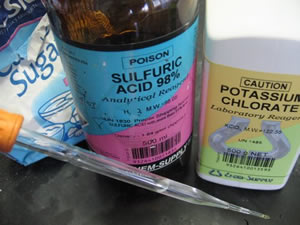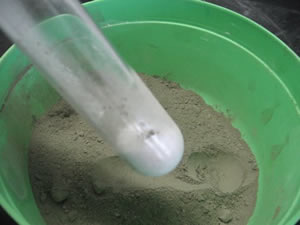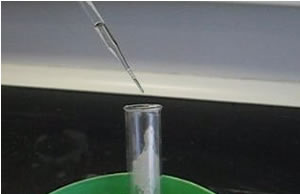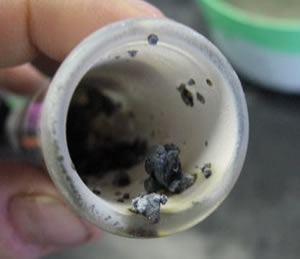Rapid oxidation of sugar
with potassium chlorate

Mix sugar and potassium chlorate in a test tube. Only small quantities, as pictured on the right, should be used. Use the granulated sugar and not the powdered sugar.
Place the test tube in sand to protect the container from the extreme heat generated.

Place one drop of concentrated sulfuric acid on to the mixture.
When sulfuric acid is introduced heat is created which decomposes
potassium chlorate to produce oxygen according to the equation below.
2KClO3(s) + heat —> 2KCl(s) + 3O2(g)

Some of the products of the reaction are shown on the right. Black pieces of carbon can be seen inside the test tube. Other products include carbon dioxide, water and of course heat.

Equipment:
- concentrated sulfuric acid
- large test tube.
- 9.00 grams sugar
- 9.00 grams KClO3
- dropper
- plastic container with sand.
Mix the sugar and potassium
chlorate in a test tube. Use the granulated sugar and not the powdered
sugar.
Place the test tube with the mixture in the sand. Drop one drop of sulfuric
acid in the test tube to initiate the reaction.
Safety equipment - lab coat and goggles. This demonstration must be performed outdoors or in a well ventilated fume cupboard.
Theory.
We suspect that chloric acid
(HClO3) is formed when potassium chlorate (KClO3
) and sulfuric acid (H2SO4 ) are mixed. Chloric
acid rapidly decomposes organic material, such as sugar, with the release
of enormous amounts of heat energy.
The exothermic reaction proceeds according to the equation below with
the release of 2029 kJ of energy per mol of sugar reacting.
C12H22O11(s) + 8KClO3(s) =>
12CO2(g) + 11H2O(g) + 8KCl(s)
The heat released from the
above reaction quickly fuels a second reaction given by the equation below.
C12H22O11(s) => 12C(s)
+ 11H2O(g) .
This reaction gives off even
more energy to the tune of 429 kJ for every mol of sugar that reacts.
The solid carbon (graphite) formed is visible after the reaction has ceased.
Senior Chemistry
questions
Atomic masses: K = 39.0, Cl = 35.5, C = 12, O = 16, H = 1.
1) Calculate the mol of potassium chlorate used.
2) Calculate the mol of sugar used.
Sugar reacts with potassium chlorate according to the equation below
C12H22O11(s) + 8KClO3(s)
=> 12CO2(g) + 11H2O(g) + 8KCl(s)
3) Which reactant is in excess?
How many KJ of energy will be released from this reaction mixture?
4) Adding more sugar to the mixture slows the reaction down. Explain why? Click
to see a 1 Mb video.
5) What is the mass of potassium chlorate that is needed to completely react with 10 grams of sugar?